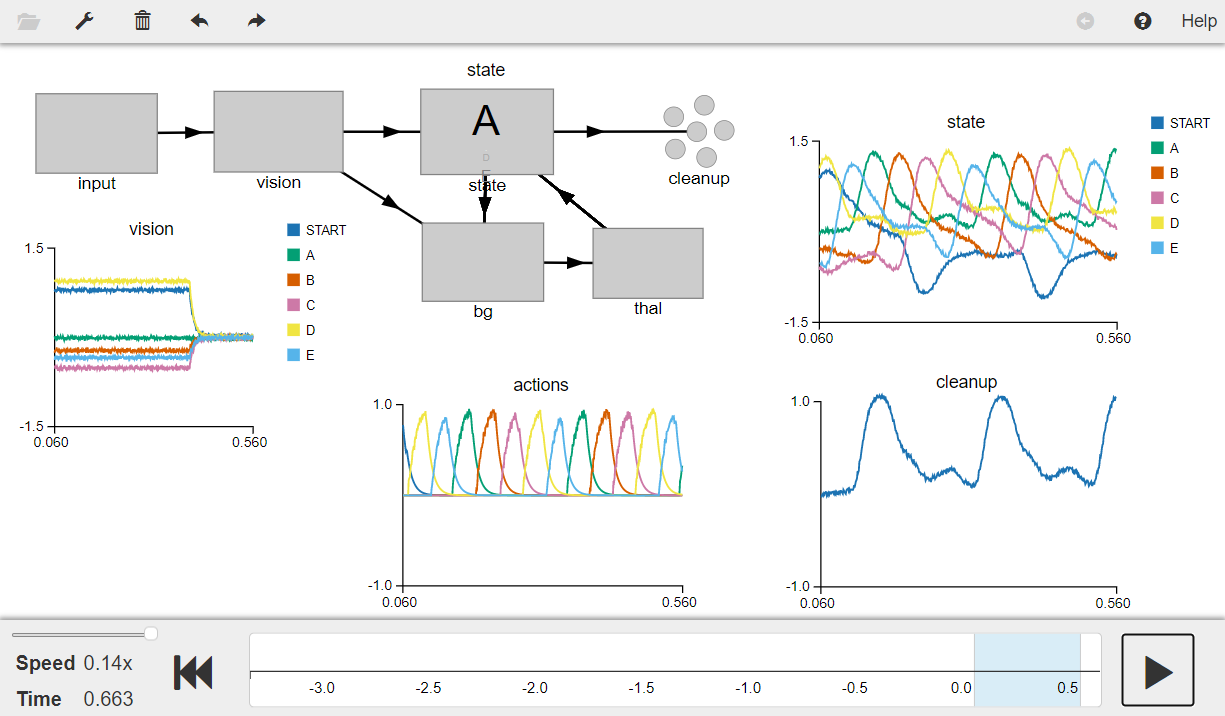- NengoLoihi
- How to Build a Brain
- Tutorials
- A Single Neuron Model
- Representing a scalar
- Representing a Vector
- Addition
- Arbitrary Linear Transformation
- Nonlinear Transformations
- Structured Representations
- Question Answering
- Question Answering with Control
- Question Answering with Memory
- Learning a communication channel
- Sequencing
- Routed Sequencing
- Routed Sequencing with Cleanup Memory
- Routed Sequencing with Cleanup all Memory
- 2D Decision Integrator
- Requirements
- License
- Tutorials
- NengoCore
- Ablating neurons
- Deep learning
Routed Sequencing with Cleanup Memory¶
This model extends the routed sequencing model by creating a scalar ensemble cleanup as explained in the book. You will project the state on to the cleanup ensemble using a transformation matrix pd, specified by the vocabulary vector A. This implies that each component of the state vector (i.e., the cortical element) is multiplied by the corresponding component of the A vector and summed to produce a one dimensional quantity represented by the cleanup ensemble. This
operation is similar to the dot product of the state vector and the vocabulary vector A.
[1]:
# Setup for the notebook
import numpy as np
import nengo
from nengo import spa
from nengo.spa import Vocabulary
Create the Model¶
This model has parameters as described in the book, with a one dimensional cleanup ensemble consisting of 100 neurons.
[2]:
# Number of dimensions for the Semantic Pointers
dim = 16
# Change the seed of this RNG to change the vocabulary
rng = np.random.RandomState(4)
vocab = Vocabulary(dimensions=dim, rng=rng, max_similarity=0.1)
# Make a model object with the SPA network
model = spa.SPA(label="Routed_Sequence with cleanupA", vocabs=[vocab])
# Create the spa.SPA network to which we can add SPA objects
with model:
# Specifying the modules to be used
model.state = spa.State(dimensions=dim, feedback=1, feedback_synapse=0.01)
model.vision = spa.State(dimensions=dim)
# Specify the action mapping
actions = spa.Actions(
"dot(vision, START) --> state = vision",
"dot(state, A) --> state = B",
"dot(state, B) --> state = C",
"dot(state, C) --> state = D",
"dot(state, D) --> state = E",
"dot(state, E) --> state = A",
)
# Creating the BG and thalamus components that confirm to the specified rules
model.bg = spa.BasalGanglia(actions=actions)
model.thal = spa.Thalamus(model.bg)
# Get the transformation matrix (pd) and create the cleanup ensemble (cleanup)
pd = [model.get_output_vocab("state")["A"].v.tolist()]
model.cleanup = nengo.Ensemble(n_neurons=100, dimensions=1)
# Function that provides the model with an initial input semantic pointer.
def start(t):
if t < 0.4:
return "0.8*START+D"
return "0"
# Input
model.input = spa.Input(vision=start)
# Projecting the state of the cortex on to the cleanup ensemble using a
# transformation matrix 'pd'.
nengo.Connection(model.state.output, model.cleanup, transform=pd)
Run the Model¶
[ ]:
# Import the nengo_gui visualizer to run and visualize the model.
from nengo_gui.ipython import IPythonViz
IPythonViz(model, "ch7-spa-sequence-routed-cleanup.py.cfg")
Press the play button in the visualizer to run the simulation. You should see the graphs as shown in the figure below.
The graph on the bottom-left shows the semantic pointer representation of the values stored in the state and the response of the cleanup population is shown in the plot on the bottom-right. The plot on the top-right shows the utility (similarity) of the current Basal Ganglia input (i.e., state) with the possible vocabulary vectors. Since the cleanup operation is similar to a dot product between the state of the cortical element (state) and the defined vocabulary vector A, the
value of the cleanup population rises only when the state (top-right graph) is A.
[3]:
from IPython.display import Image
Image(filename="ch7-spa-sequence-routed-cleanup.png")
[3]:
